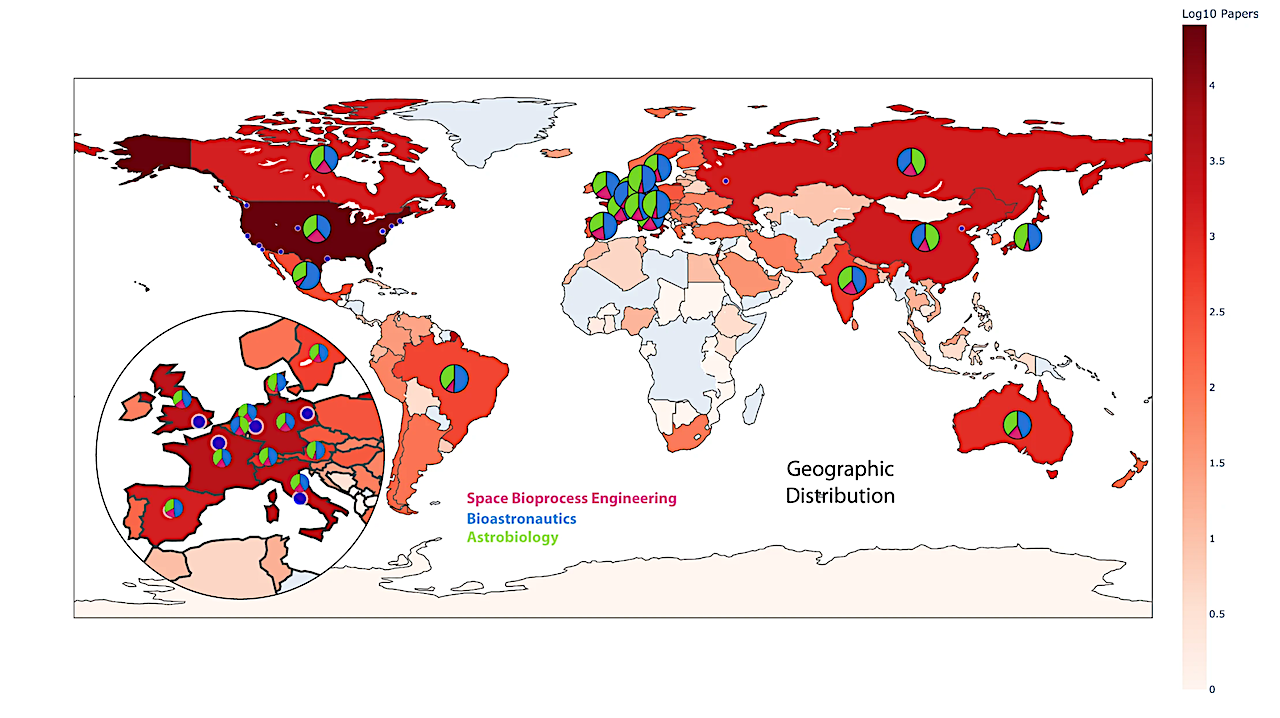The distribution of space life science research is depicted geographically, with the number of papers represented on a log scale in red for all countries included in the bibliometric analysis. Additionally, scattered blue dots pinpoint cities with the highest citation counts. For the top 20 countries, the breakdown of citations is illustrated in a pie chart, showcasing the contributions in Astrobiology (green), Bioastronautics (blue), and Space Bioprocess Engineering (pink). Countries with a light blue background indicate a lack of records.
The fusion of biology and space exploration has given rise to three interconnected disciplines: Astrobiology, Bioastronautics, and Space Bioprocess Engineering. Astrobiology delves into the origins, evolution, distribution, and future of life in the universe. Bioastronautics focuses on the impact of space travel on biological systems, encompassing human physiology and psychology. Conversely, Space Bioprocess Engineering is concerned with the development, deployment, and supervision of biotechnology for human space exploration.
This paper underscores the distinct contributions of each field and elucidates opportunities for biologists to engage in these captivating realms of study. By offering a comprehensive overview of the primary domains of biology and space exploration, this paper serves as a valuable asset for scientists and researchers keen on exploring the intersection of these disciplines.
IMAGES: The complete research corpus for each discipline was extracted directly from Scopus in RIS format following the input of the relevant query. The RIS files were exported with metadata on document titles and corresponding author keywords. Subsequently, the bibliometric visualization tool VOSviewer was utilized to transform this data into a network graph, featuring the top 100 most frequently occurring keywords for each discipline. The size of keywords and nodes scales with their prevalence within the visualized discipline. The nodes and edges of the network were automatically colored based on VOSviewer’s clustering algorithm, where each color denotes a distinct cluster—nodes within a cluster co-occur more frequently, indicating shared research focuses. The number of clusters for Astrobiology, Bioastronautics, and Space Bioprocess Engineering are 5, 6, and 12, respectively. In Fig. 3, the nodes and edges of the network were colored according to VOSviewer’s clustering algorithm, with each color representing a unique cluster—nodes within a cluster co-occur more frequently, suggesting shared research themes. These colors may differ from those in Fig. 1 and 2.
Authors: J. Berliner, Spencer Zezulka, Gwyneth A. Hutchinson, Sophia Bertoldo, Charles S. Cockell & Adam P. Arkin
